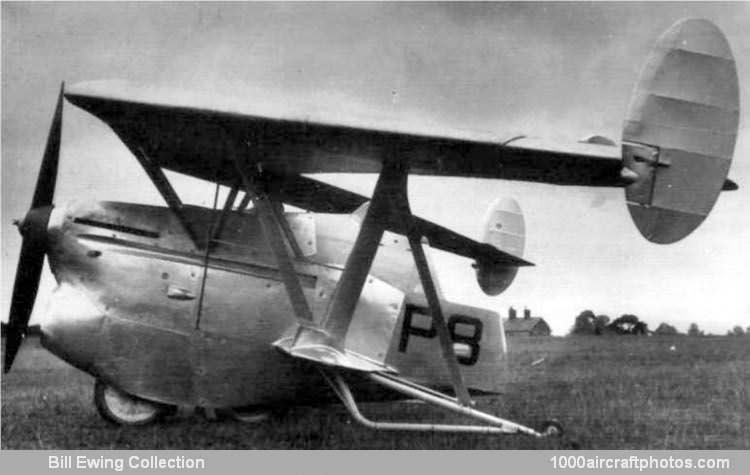Initial design led to the Air Ministry Specification F.3/32, calling for a prototype of what was to become designated as the Pterodactyl V. The two-seat tailless braced sesquiplane fighter differed very considerably from the Mk IV of only two years earlier. The central nacelle mounted a 600 hp Rolls-Royce Goshawk twelve-cylinder steam-cooled V-engine at its forward end, this driving a two-blade fixed-pitch tractor propeller. Basic structure of airfoil surfaces was of metal, covered with fabric, while the central nacelle basically had an all-metal structure.
Directly above the lower wing at the rear of the nacelle, the pilot was accommodated in an open cockpit, with a gunner immediately behind him in a tail cockpit that could carry an electrically-actuated gun turret with one or two Lewis guns. Further armament consisted of two forward-firing synchronized Vickers machine guns under pilot's control, while provisions were made to carry light bombs. Faired into the lower surface of the nacelle was the tandem wheel main landing gear unit, with little more than the wheel tires exposed. The forward wheel was steerable, and the aft wheel incorporated brakes.
At the lower surface of the nacelle a narrow-chord short span conventional wing was mounted. Beneath this wing, and adjacent to the tips, the trailing skids of the landing gear were mounted. Above were struts which, together with cabane struts and wire bracing, supported the upper swept wing. This differed in planform from earlier designs, having a wide un-swept center section, and outer panels swept at 42.5° on the leading edge. In its original form this upper wing incorporated wing tip rudders with elevons immediately inboard, and automatic leading edge slats adjacent to the wing tips.
Little time had been lost in building this new aircraft, and it was in early February of 1933 when it was wheeled out at Yeovil for engine running and first taxi trials, before being dismantled for trans-port to Andover for the first flight. The first taxiing test proved to be something of an anti-climax, for within minutes of the chocks being waved away the port outer wing collapsed. Apparently the interplane struts were inadequately stressed, and failed from an unexpected load imposed by the struts of the port balancing skids.
It was not until fifteen months later, during May 1934, that Harald Penrose was able to take the controls at Andover. Five taxiing runs preceded the take off, followed by a promising first flight of about 20 minutes. However, there were many problems to be faced, involving not only the airframe, but also the Goshawk engine. This introduced a steam (more accurately evaporative) cooling system that proved to be unreliable, and which was responsible for the termination of Goshawk production after only a small number of examples had been built.
Additionally, the torque of this engine raised ground handling problems that had not been completely overcome even after the tandem main wheels had been slightly offset, and small wheels added to the balancing skids. Airframe modifications were to include the leading edge slats being moved further inboard, the addition of under-wing fins just inboard of the elevons, and the wing tip rudders increased in size to become combined fins and rudders. At a later stage the area of the under-wing fins and of the wing tip rudder /fins was increased, and to improve directional stability the wing tip vertical surfaces were canted outward.
Development of the Pterodactyl V lost some impetus after Geoffrey Hill left Westland Aircraft in late 1934. With most of its bugs ironed out, however, and with the 'Class B' marking P-8 (later serialed K2770), it was duly handed over to the RAE at Farnborough for testing. It was to be abandoned later, after evaluation had led to the conclusion that it was not sufficiently advanced by comparison with contemporary conventional fighters in service or under development."
